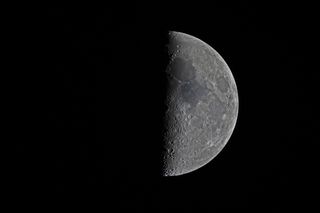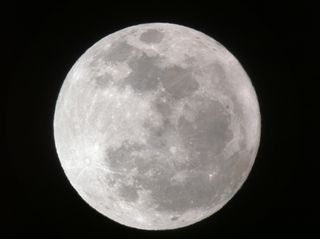
Back in early September 2013, Venus and Saturn paired off nicely in the western evening sky. I had taken my 10-inch (25 centimeters) telescope out to examine Venus' small, gibbous disk as well as the famous rings of Saturn, which were starting to turn toward Earth again after having appeared edge-on just a few years earlier.
Whenever I take out my scope, I attract a few of my neighbors, and I always offer them a look through the eyepiece. On this particular night, the Harvest full moon was rising in the east, and one of my neighbors, with her young daughter in tow, made a request: "Could you point your telescope to the moon so that we could see it? This is probably the best time to look at the moon, right?"
"Actually," I said, "this is probably the absolute worst time to look at it, and I wasn't planning on looking at it at all this evening." [The Moon: 10 Surprising Lunar Facts]

"Wait," I said. "I'll let you tell me."
I swung my telescope away from the two planets and pointed it toward the full moon, which was now well up in the east. When I got it in view, I invited my neighbor to take a look. "Wow! That's amazing!" was her first reaction, but quickly I noticed she was squinting noticeably. When she took her eye away, she said, "Boy! That thing is incredibly bright!"
"Yep," I said. "And did you notice that the moon didn't look like a globe or sphere at all? Instead, it looks as flat as a plate — very one-dimensional."
After I showed the moon to her daughter, I swung the scope back around to look at the planets. Then I told my guests when they could get a more pleasing lunar view: at the time of the "half-moon," also known as the first- or last-quarter phase, and those few days just after first quarter or just before last quarter. At those times, skywatchers get the best views of the moon, along the line separating its illuminated and shadowed parts — the sunrise-sunset line, or "terminator." [Earth's Moon Phases, Monthly Lunar Cycles (Infographic)]
Get the Space.com Newsletter
Breaking space news, the latest updates on rocket launches, skywatching events and more!
Around the times of the two quarter phases, observers can examine the moon with small telescopes, or even pairs of binoculars, and see a fascinating play of light and shadow near and along the terminator. The features lying close to the terminator stand out in sharp, clear relief.
And take note of how sharp that line is. If observers were to look at Earth from the moon, they would note how diffuse the terminator would appear; thanks to this planet's atmosphere, a twilight zone softens the break between day and night. But on the airless moon, there is no twilight at all.
The moon arrives at first-quarter phase tonight (July 11) at 8:56 p.m. EDT (0056 GMT on July 12). That will be the moment when its disk is exactly 50 percent illuminated. Check out the moon at that time with the naked eye or with binoculars or a small telescope, and you'll see the terminator perfectly bisecting the lunar disk, with the bright half on the right and the dark half on the left.
Lunar mountains will be readily visible, as the sun lights them from the right. Several hours before first-quarter arrival, if you look carefully enough, you'll notice that the terminator is ever so slightly concave, revealing that the moon still has a crescent shape. Study the moon carefully several hours after the time of first quarter, and you'll see that the terminator is just slightly convex, having transitioned to a gibbous ("hump") shape.
Also, when viewing through a telescope, it's easier on the eyes to observe a first-quarter moon than a full moon.
It might seem like a quarter-phase moon should be half as bright as a full moon, but this isn't the case; the first-quarter moon is actually just 9 percent as bright as a full moon. This is because a half moon is heavily shadowed, even on its illuminated half. A glance through binoculars will reveal large dark areas, the so-called seas or maria (the plural of mare), which in reality are flat lava plains. Interestingly, a first-quarter moon is just a tad brighter than a last-quarter moon, because at last quarter, viewers see more of the dark maria.
In contrast to a half moon, a full moon is almost completely illuminated, especially around its center; the sun shines straight down even into all the tiny crevices, and, except for perhaps around the lunar disk's edges, you will see no shadows at all. In fact, if you're under very dark skies — an open field in the countryside, say — the light reflected by a full moon will even cast rather distinct shadows. Its disk is absolutely dazzling. No wonder my neighbor had to squint when looking at this bright moon through my telescope!

When the moon is at the more favorable half or gibbous phase, I love to stick a high-power eyepiece in my telescope, then put the moon outside the telescope field. Then, I let Earth's rotation spin the moon slowly, almost majestically, across my field of view. This gives the impression of being in an Apollo command module, seemingly orbiting the moon while looking out one of the windows and down upon the jagged lunar landscape. If you have a map of the moon, it's a great way to identify lunar features.
On Wednesday evening (July 13), look along the terminator for a magnificent crater called Copernicus, named after the famed 16th-century Polish astronomer and theologian Nicolaus Copernicus. This crater, which is about 58 miles (93 kilometers) wide and 2.3 miles (3.7 km) deep, was nicknamed "Monarch of the Moon" by lunar cartographer Thomas Gwyn Elger. It is a classic example of a well-preserved, relatively young (less than 1 billion years old) lunar impact crater.
When Copernicus appears directly aligned with the terminator, as it will on Wednesday, the crater becomes the most obvious lunar feature. In the nights that follow, you'll be able to observe the crater in full sunlight surrounded on all sides by a system of bright rays extending out for nearly 500 miles (800 km), resembling a sort of lunar sunflower. Only the crater Tycho, which is located far to the south of Copernicus, boasts a more extensive system of rays.
Editor's Note: If you capture an amazing photo of the moon or any other celestial sight and would like to share the images with Space.com, you can send photos and comments to managing editor Tariq Malik at spacephotos@space.com.
Joe Rao serves as an instructor and guest lecturer at New York's Hayden Planetarium. He writes about astronomy for Natural History magazine, the Farmer's Almanac and other publications, and he is also an on-camera meteorologist for News 12 Westchester, N.Y. Follow us @Spacedotcom, Facebook or Google+. Originally published on Space.com.
Join our Space Forums to keep talking space on the latest missions, night sky and more! And if you have a news tip, correction or comment, let us know at: community@space.com.

Joe Rao is Space.com's skywatching columnist, as well as a veteran meteorologist and eclipse chaser who also serves as an instructor and guest lecturer at New York's Hayden Planetarium. He writes about astronomy for Natural History magazine, the Farmers' Almanac and other publications. Joe is an 8-time Emmy-nominated meteorologist who served the Putnam Valley region of New York for over 21 years. You can find him on Twitter and YouTube tracking lunar and solar eclipses, meteor showers and more. To find out Joe's latest project, visit him on Twitter.
Most Popular

